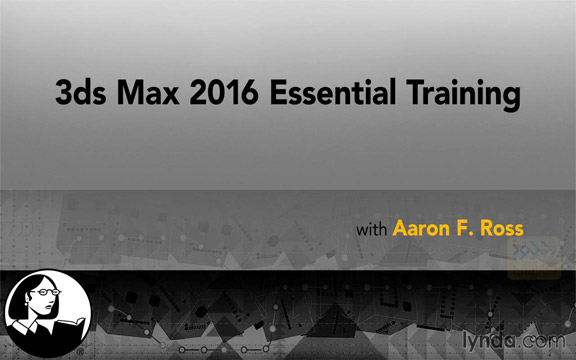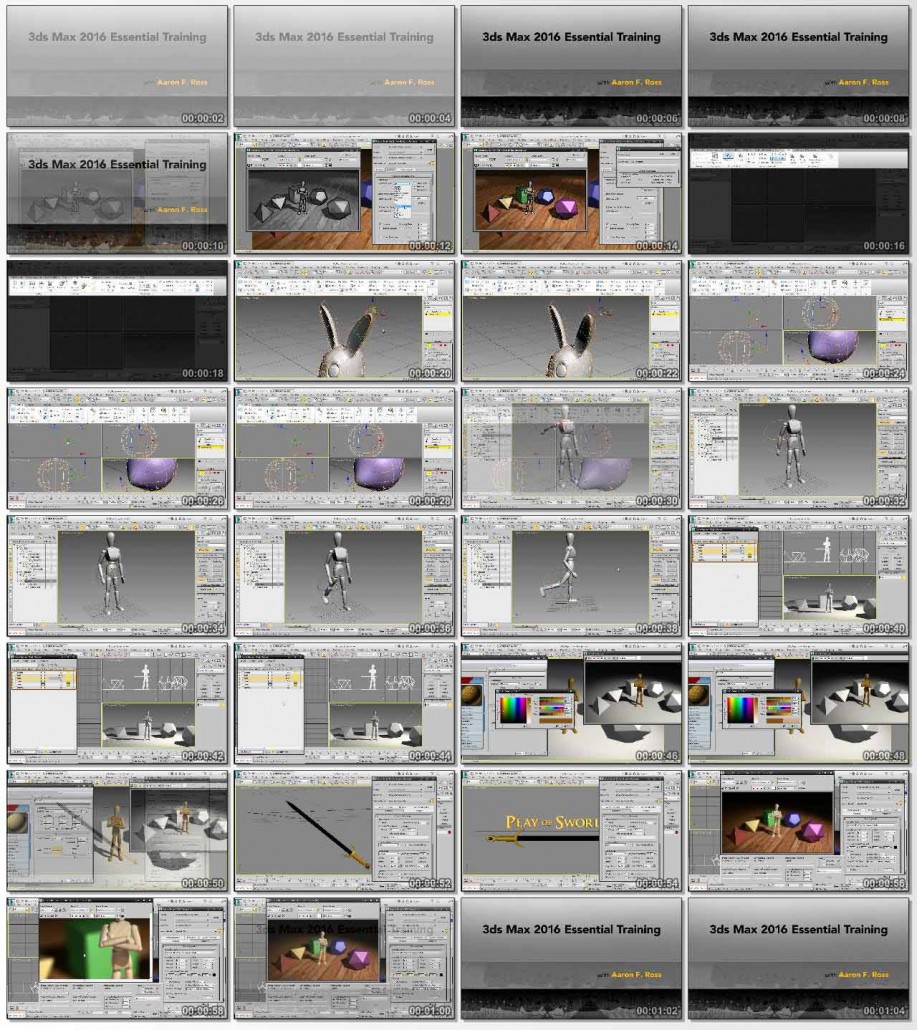
3ds Max 2016 Essential Training ، فیلم آموزشی معرفی و آشنایی با نرم افزار تریدی اس مکس 2016 می باشد که برای علاقمندان به این نرم افزار محبوب ، توسط شرکت Lynda ، تهیه و منتشر گردیده است . در این فیلم آموزشی به بررسی قابلیت 3ds Max 2016 خواهند پرداخت تا شما را بطور کامل با این نسخه آشنا نمایند . Aaron F. Ross که مدرس فیلم آموزشی 3ds Max 2016 Essential Training می باشد با ببرسی اجمالی این دوره ی آموزشی کار خود را آغاز می کند و در ادامه مواردی از قبیل مرور رابط کاربری و نمای نرم افزار ، چگونگی مدل سازی با چند ضلعی و سطوح زیربخش ، آشنایی با فرم آزاد مجسمه سازی ، آشنایی با مدل سازی برای حرکت های گرافیکی و بسیاری موارد دیگر را آموزش میدهد تا بتوانید با بهرگیری از این آموزش براحتی از آن استفاده نمایید . همچنین برای درک بهتر این مفاهیم می توانید همزمان با دیدن فیلم آموزشی 3ds Max 2016 Essential Training از پروژه ی تمرینی موجود نیز استفاده نمایید .
تصاویری از فیلم آموزشی 3ds Max 2016 Essential Training

مباحث دوره ی آموزشی 3ds Max 2016 Essential Training :
– Navigating the interface and viewports
– Understanding the Modifier Stack
– Modeling with polygons and subdivision surfaces
– Freeform sculpting
– Modeling with splines and NURBS
– Linking objects in hierarchies
– Modeling for motion graphics
– Framing shots with cameras
– Creating and editing keyframes
– Controlling lights and shadows
– Building materials
– Texturing with bitmaps and procedurals
– Painting objects with Viewport Canvas
– Rendering a sequence
– Adding special effects with mental ray
موارد مورد بحث در 3ds Max 2016 Essential Training :
00. Introduction
– Welcome
– Using the exercise files
01. Getting Started
– Using project folders
– Customize user interface and defaults
– Setting preferences
02. 3ds Max Interface
– Getting familiar with the interface
– Using the Create and Modify panels
– Configuring viewports
– Choosing units of measurement
– Controlling the grid display
– Navigating in viewports
– Using hotkeys
– Transforming objects
– Choosing shading modes
03. Modeling Basics
– Working with Scene Explorer
– Creating an image plane
– Controlling Display properties
– Creating primitives
– Understanding level of detail
– Working with the modifier stack
– Understanding dependencies
– Collapsing the modifier stack
04. Polygon Modeling
– Using the Ribbon with editable polys
– Working with subobjects
– Welding vertices
– Choosing a transform center
– Detailing with Cut and Remove
– Detailing with QuickSlice
– Using soft selection
– Faceting corners with Chamfer
– Using Window/Crossing Selection
– Using Paint Selection
– Combining objects with Attach
– Joining elements with Bridge
– Branching polygons with Extrude
– Smoothing and hardening edges
05. Subdivision Surface Modeling
– Understanding subdivision surfaces
– Creating an editable poly object
– Adding the Symmetry modifier
– Choosing NURMS or TurboSmooth
– Roughing out the shape
– Inserting edge loops with SwiftLoop
– Constraining subobject transforms
– Welding the seam
– Adding asymmetry
– Baking subdivisions
06. Free-Form Modeling
– Sculpting with Paint Deform
– Using Noise and Relax Brushes
– Setting Paint options
– Controlling Brush options
– Conforming one object to another
– Sculpting with Conform Transform brushes
– Duplication with Object Paint
– Positioning objects with Select and Place
07. Spline Modeling
– Creating a line
– Moving a pivot point
– Revolving a surface with a Lathe modifier
– Using different vertex types
– Using axis constraints
– Extending a spline
– Snapping an Arc primitive
– Combining splines with Attach and Merge
– Rounding corners with Fillet
– Offsetting a spline with Outline
– Adjusting level of detail with Interpolation
08. NURBS Modeling
– Grouping objects
– Understanding NURBS
– Creating NURBS curves
– Converting objects to NURBS
– Cloning subobjects
– Creating a U loft surface
– Rebuilding curves
– Setting Surface Approximation
09. Hierarchies
– Understanding hierarchies
– Linking objects
– Moving and rotating pivot points
– Understanding coordinate systems
– Setting Axis Order for rotation
– Using the Schematic view
– Locking transforms
– Avoiding problems with scale
10. 3D Motion Graphic Design
– Exporting paths from Adobe Illustrator
– Importing Illustrator paths to 3ds Max
– Creating a Text primitive
– Applying a Bevel modifier
– Instancing a modifier
– Editing text splines
– Viewport clipping
– Controlling level of detail
– Editing polygons
11. Layout and Camera Basics
– Merging scenes
– Managing display layers
– Creating a target camera
– Choosing aspect ratio in Render Setup
– Enabling Safe Frames
– Adjusting Field of View
-Using a free camera
6m 48s
12. Keyframe Animation
– Setting up Time Configuration
– Choosing Set Key Filters
– Creating keyframes in Set Key mode
– Editing keyframes in the timeline
– Editing position keys with trajectories
– Editing function curves in the Curve Editor
– Creating keyframes in Auto Key mode
– Building up animation in passes
– Editing keyframes in the Dope Sheet
13. Controllers and Constraints
– Understanding controllers
– Assigning a Link constraint
– Adding link targets in the Motion panel
– Animating constrained objects
– Constraining animation to a path
14. Lighting Basics
– Correcting gamma
– Understanding CG lighting
– Creating a target spotlight
– Using the Light Lister
– Adjusting intensity and color
– Setting spotlight Hotspot and Falloff
– Previewing renders with ActiveShade
– Controlling contrast and highlights
– Choosing a shadow type
– Optimizing shadow maps
– Optimizing area shadows
– Creating Omni fill lights
– Excluding objects from lights
15. Materials Basics
– Using the Slate Material Editor
– Choosing material and shading types
– Working with scene materials
– Adjusting specular parameters
– Assigning Multi/Sub-Object materials
16. Mapping Textures
– Applying 3D procedural maps
– Working with bitmap image files
– Tracking scene assets
– Projecting UVW mapping
– Using Real-World Map Size
– Mapping a bump channel
– Adding reflections with a Raytrace map
– Painting objects with Viewport Canvas
17. Rendering Basics
– Choosing a renderer
– Choosing Quicksilver options
– Enabling Motion Blur in the software renderer
– Rendering image sequences
– Playing image sequences in the RAM Player
18. Rendering with mental ray
– Controlling mental ray sample quality
– Tuning Final Gather
– Enabling Motion Blur in mental ray
– Distance blurring with Depth of Field
19. Conclusion
– Goodbye
مشخصات دیگر فیلم آموزشی 3ds Max 2016 Essential Training :
– ژانر : آموزشی
– شرکت سازنده : Lynda
– مدرس : Aaron F. Ross
– مدت زمان آموزش : 10 ساعت و 44 دقیقه
– پروژه ی تمرینی : دارد
– نرم افزار مورد نیاز : 3ds Max 2016
– تاریخ انتشار : 22-05-2015
– زبان : انگلیسی
– کیفیت نمایش : 720 * 1280
– فرمت فایل : mp4
– زیرنویس : ندارد
برای درخواست فیلم های آموزشی به اینجا مراجعه کنید .











what is the password to extract the files ???
www.download.ir
شما عالی هستید
نمیشه تخفیف بدین ؟؟؟؟
با شماره ی فروشگاه تماس بگیرید .
021-88544768